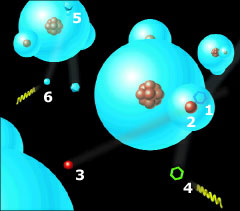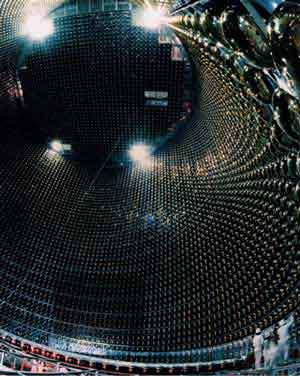|
|
|
|
|
|
|
|

| |||||||
 |
| Energy | Pages 112-113 | See Linked Version | ||||
|
In the world of science, such references are not far off the mark. Energy is defined as the capacity to do work--to move objects from here to there or to change their configuration somehow. Nature features as many varieties of energy as does our informal language. We use mechanical energy to pick things up and put them down. Electrical energy lights our homes and runs our appliances. The chemical energy produced in our cells keeps our bodies going. Moving objects have energy, and so do unmoving ones. Noise is energy; heat and light are energy. Strangely enough, even matter is energy. These interrelationships show why motion, matter, and energy are so closely linked when it comes to describing the universe. The diverse forms of energy also explain why studying it has posed such a challenge to physicists in the past three centuries. The importance of the quest to understand energy in its many guises cannot be overstated. After all, energy powers the universe. Energy has a place alongside momentum as a fundamental conserved quantity. The physics of the world around us depends on the fact that the total amount of energy within a system remains the same, unless an outside force acts upon it. Energy is never created or destroyed. Any time it seems to disappear, it has merely changed into another form. We can use this critical principle to track the peaks and valleys of (continued) |
||||
|
| ||||
| Elusive Stellar Messengers When a blue supergiant star in a neighboring galaxy exploded into history as Supernova 1987A, it spewed countless trillions of ethereal particles called neutrinos into space. Nearly 170,000 years later 19 of them were detected as the swarm passed through Earth. The detection was indirect, recording not the neutrinos themselves but the byproducts of their interactions with molecules of water (right). Several hours before the supernova was noticed in the sky, the underground Kamiokande detector in Japan recorded the arrival of 11 of these elusive specks. Halfawy around the world, a detector in an Ohio salt mine counted eight more. Though seemingly sparse, these results supported the prevailing theory that a supernova explosion releases more than 99 percent of its energy in the form of these nearly massless particles. Today, other detectors, including a mammoth successor to Kamiokande called Super-Kamiokande (see below), continue to track the passage of these interstellar mites in hopes of understanding their eleusive nature and determining their mass. |
 An electron-antineutrino (1) bangs into the single proton that is the nucleus of the hydrogen atom (2), yielding a neutron (3) and a positron (4) that emits a flash of light. At top left, an electron neutrino (5) nicks an oxygen atom and knocks loose an electron (6) with enough force to produce light. The light flashes are picked up by sensors deep beneath Earth's surface. (see below) | |||
|
| ||||
 |
Super-Kamiokande, located near the town of Kamioka in north-central Japan, is the world's most powerful neutrino detector. Shown here drained of the 32,000 tons of water it usually holds, the detector is a cylindrical tub 128 feet across and 138 feet high, buried two-thirds of a mile underground. More than 10,000 light- sensitive tubes line the walls of the detector, constantly watching for faint flashes of light created by the rare collisions of neutrinos with water molecules. | |||
|
| ||||